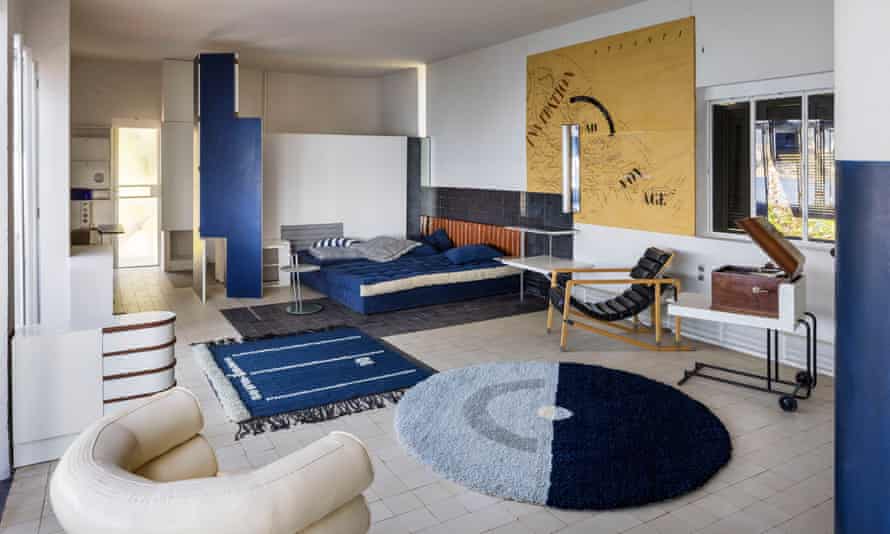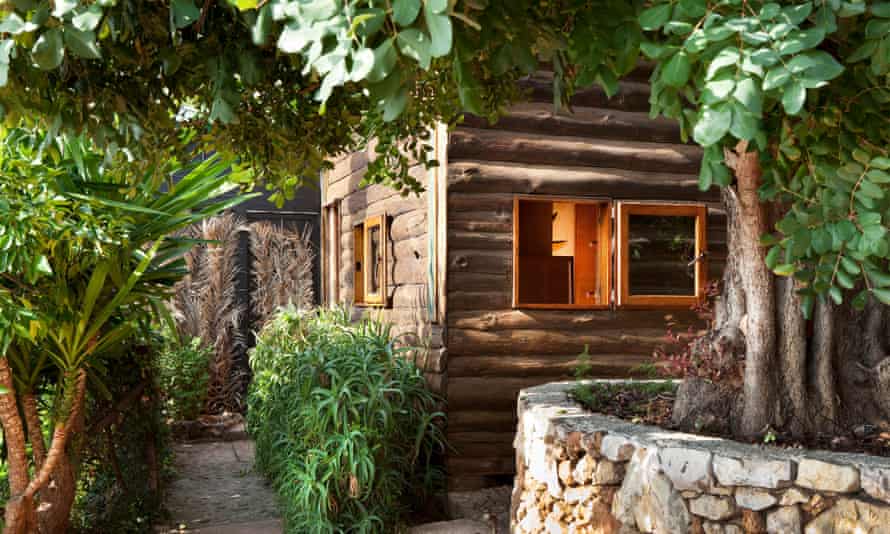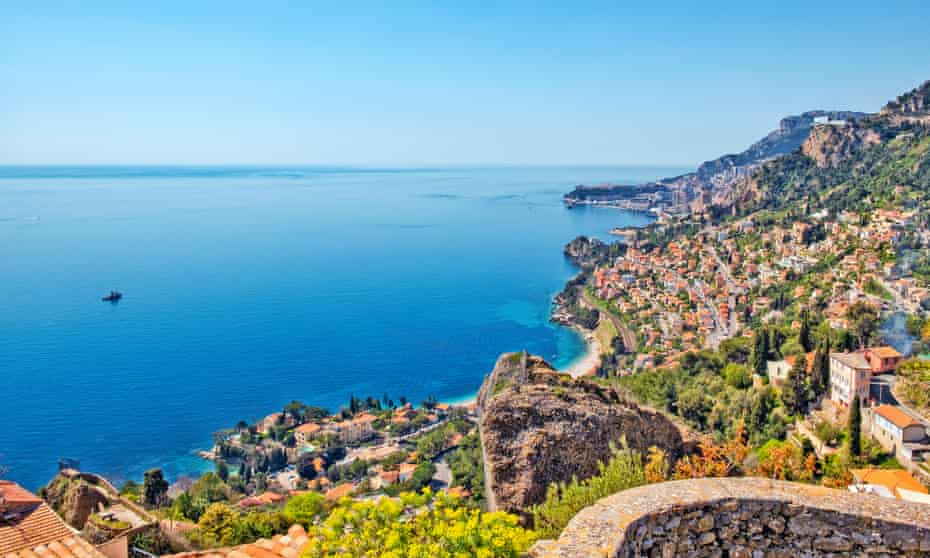I wish I had a beach hut like Le Corbusier’s. A perfect place to self-isolate on the French Riviera’s wildest stretch of coastline.
The Swiss-born architect chose Roquebrune-Cap-Martin, halfway between Monaco and the Italian border, to build his retreat in a medieval village that overlooks a rugged, tortoise-shaped cape beyond the pebble beaches of du Buse and Golfe Bleu.
Having persuaded his friend, the local bar owner Thomas Rebutato, to offer him some land overlooking the plage du Buse, Le Corbusier constructed a prototype holiday cabin – Le Cabanon – in 1952, adjoining Rebutato’s Etoile de Mer restaurant-bar (including a secret door between the two). In exchange, he designed a block of five colourful camping units on stilts above the bar’s boules court, Les Unités de Camping. To take a look inside, visitors have to book with Association Cap Moderne.

Le Cabanon is the essence of Le Corbusier’s design philosophy: a wooden cabin with yellow parquet floor, box-stools to reach overhead cupboards, a steel washbasin and unadorned oak furniture. Yvonne, his wife, slept next to the tiny toilet and Le Corbusier on a pull-out bed in another corner.
Could I have spent the long, hot summers there like they did? There’s no kitchen and only an outdoor shower under the carob tree. The cabin’s dimensions are based on Le Corbusier’s Modulor, a 1.829 metre-tall human, a version of which is painted on one side of the camping units and which, coincidentally and fantastically, is my exact height.
On the same coastal footpath is Villa E-1027, a modernist masterpiece designed by Irish architect and modern movement pioneer Eileen Gray and her lover, Jean Badovici, in the late 1920s. It looks like a cruise liner, sharp-edged in concrete and glass with reproductions of Gray’s chrome, glass and leather furniture inside (including her Bibendum chair). She wasn’t a fan of Le Corbusier, the man.

The €5.5m restoration of illa E-1027 was completed in 2021 and includes the recreation of its fittings and furniture using her original methods and materials. Besides reinforcing the concrete walls, adding electrical circuits and recreating Gray’s geometric-motif rugs, her complex writing table has been meticulously reproduced from a single, surviving photograph. Association Cap Moderne, which manages the site, hopes to include a research centre for academics alongside the villa, Le Corbusier’s Cabanon, his camping units and the former Etoile de Mer beach bar.

I walk across the pebbly bay to the other Le Cabanon, a swish beach restaurant specialising in Ligurian-style seafood and pasta – cuttlefish salad, seared tuna with mint, lime and courgettes followed by a lemon sorbet, the local speciality. It’s a favourite of the couple swimming towards me between the outcrops of Roquebrune puddingstone. Nancy and PJ Heslin, both Ironman competitors and swim-runners, moved to Roquebrune two years ago from Nice, 20km away.
“We both work in Monaco, and when we were trying to find somewhere to live we took the train to Roquebrune and just swam back along the coast, looking for places with stair access to the beach,” says PJ. They adore Roquebrune’s calmness: “It’s a place where you can really connect with nature,” says Nancy. “The open-water swimming is amazing; we do three 5 to 10km swims a week. If we head along the Cap, there’s seagrass, tons of fish and a few natural springs where the water goes really cold.” They often see dolphins, and, “Since there’s no vehicle access to Golfe Bleu, it’s never crowded,” says PJ.

My walk from the plage du Buse to Roquebrune village takes a good 40 minutes – even for the Modulor me – up a hillside of disjointed staircases, steep slopes and vaulted passages which take me eventually to the 10th-century chateau. On every corner there’s a cat, a hand-painted flowerpot or signs to the nearest defibrillator. Chateau visitors have been down by a half since the pandemic, but the village restaurants are still popular: Casarella is great for a lunchtime pasta and Au Grand Inquisiteur for hearty French fare in the chateau’s vaulted former sheepfold. The metal sign outside says it was established in 1965 but it could easily have been 1265. La Grotte et L’Olivier, on the Place des Deux Frères, is half-airy terrace, half-cave, the cave part having been created when roadbuilders failed to fully tunnel through the puddingstone, so they just stopped.
Roquebrune-Cap-Martin has attracted a different Riviera crowd from the Monaco jetset and holidaying aristocrats in neighbouring Menton. Belgian singer Jacques Brel wrote two of his most plaintive and brutal songs – Le Plat Pays, about the flat, windswept landscape of his family’s native Flanders, and Amsterdam, about the shore-leave antics of drunken sailors – while lying on a sunbed in his villa on the plage du Golfe Bleu in the 1960s. WB Yeats spent the last year of his life in Cap Martin and author and war-pilot Romain Gary lived with his English wife, the writer and adventurer Lesley Blanch, at the end of a dark passageway in Roquebrune.

Gary won the Prix Goncourt, France’s most prestigious literary prize, in 1956, but had left the village (and Blanch) by the time he won it again in 1975, hoodwinking the Goncourt jury under the pseudonym Émile Ajar. He used to walk every morning to the enormous olive tree at the eastern edge of the village. Estimated to be 2,500 years old, it’s probably the oldest living thing in France. It still produces tiny, picholine olives.
My view from the olive tree is astonishing: elephant-grey peaks overhanging a hillside of apartments and tiny blue pools, paragliders and the occasional helicopter heading towards Monaco’s skyscrapers in the distance.
Le Corbusier, who probably could have chosen anywhere in the world to build a beach hut, opted for living among the “savages”, as he called the locals (jokingly), on this section of wild Riviera seaside.
Hotel Le Roquebrune has doubles, all with sea view, from €120, le-roquebrune.com. Le Cabanon beach restaurant serves mains from €16. It also has a new food truck, La Stazione du Cabanon, in the railway station car park.
Reservations for visits to Le Corbusier’s Le Cabanon, the Unités de Camping and Villa E-1027 and Etoile de mer can be made via Cap Moderne. Visits last two hours. Adults €18, concessions €10





